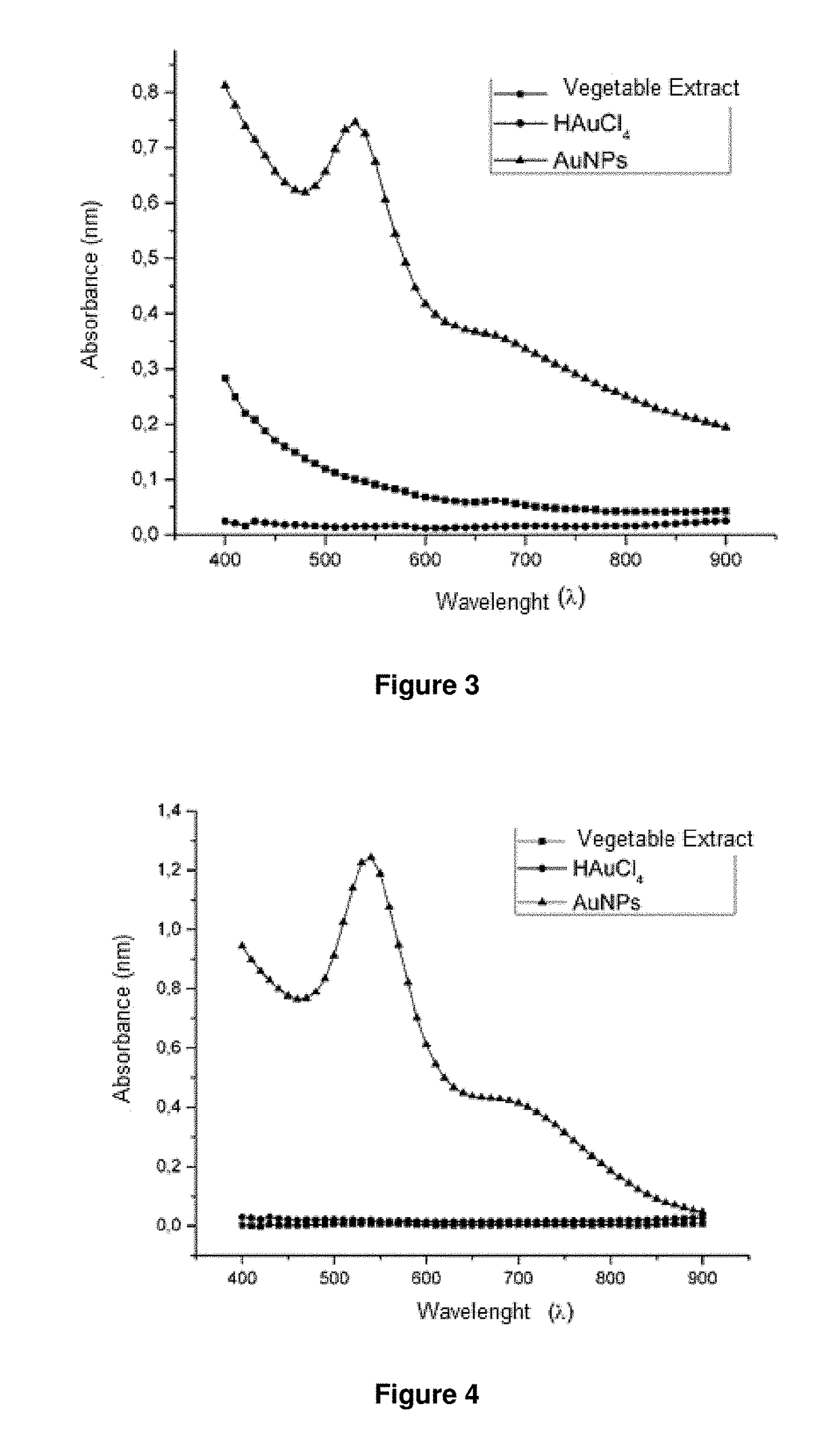Method for producing gold nanoparticles in plants and gold nanoparticles produced
a technology of gold nanoparticles and plants, applied can solve the problems of no studies in the field of nanotechnology using leaves, stems, seeds, fruits or latex extracts
- Summary
- Abstract
- Description
- Claims
- Application Information
AI Technical Summary
Benefits of technology
Problems solved by technology
Method used
Image
Examples
example 1
Extract Preparation
[0050]To obtain the vegetable extract the following steps were followed:[0051]for Colliguaja salicifolia, 4 g of leaves or stems are weighted.[0052]for Pittosporum undulatum, 4 g of seeds, leaves, stems or fruits are weighted.[0053]for Acca sellowiana, 4 g of pericarpium, mesocarp, stems, leaves, seeds or flowers are weighted.[0054]for Ugni molinae 4 g of fruits, stems, leaves, seeds or flowers are weighted.[0055]for Colliguaja integerrima 4 g of leaves or stems are weighted.
[0056]In all cases, the selected parts are washed with distilled water and then macerated in a mortar to separate the liquid from the solid fraction. 100 mL of distilled water are added to the later fraction and heat is applied until boiling. Both samples, the liquid fraction obtained by maceration and the resulting from the heating at 100° C., are filtrated to eliminate the insoluble particles and are stored to later use.
[0057]Alternatively, to obtain the extract, 500 μL of latex from Colligu...
example 2
n of Metallic Nanoparticles
[0058]Metallic nanoparticle synthesis was performed adding the corresponding metallic substrate directly over the solution containing the molecules from the vegetable extract. In this case, to form the gold nanoparticles (AuNPs) tetrachloroauric acid trihydrate (HAuCl4.3H2O) was used. The proportion of reactants used was 1:4, adding 200 μL of extract and 800 μL of 1 mM solution of metallic substrate and completing a 1 mL volume.
example 3
ization of Metallic Nanoparticles
a) Visual Characterization
[0059]Initial determination of nanoparticle formation was performed watching the color change of the solution containing the vegetable extract and the corresponding metallic substrate. When AuNPs formation happens, the solution turns purple-violet, characteristic color of the nanoparticle formation.
[0060]When mixing the Colliguaja salicifolia vegetable extract with tetrachloroauric acid, the AuNPs formation was detected by the color change from yellow-greenish to violet-purplish, characteristic of the AuNPs presence.
[0061]On the other hand, when mixing the Pittosporum undulatum seed or fruit extract with tetrachloroauric acid, AuNPs formation was detected by the color change from yellow to dark violet, while, with the leaves or stems extracts, the color change was from light yellow to dark pink, typical colors of AuNPs presence.
[0062]Additionally, when mixing the pericarpium or mesocarp extract from the Acca sellowiana fruit...
PUM
| Property | Measurement | Unit |
|---|---|---|
| Temperature | aaaaa | aaaaa |
| Time | aaaaa | aaaaa |
| Time | aaaaa | aaaaa |
Abstract
Description
Claims
Application Information
 Login to View More
Login to View More - R&D
- Intellectual Property
- Life Sciences
- Materials
- Tech Scout
- Unparalleled Data Quality
- Higher Quality Content
- 60% Fewer Hallucinations
Browse by: Latest US Patents, China's latest patents, Technical Efficacy Thesaurus, Application Domain, Technology Topic, Popular Technical Reports.
© 2025 PatSnap. All rights reserved.Legal|Privacy policy|Modern Slavery Act Transparency Statement|Sitemap|About US| Contact US: help@patsnap.com



